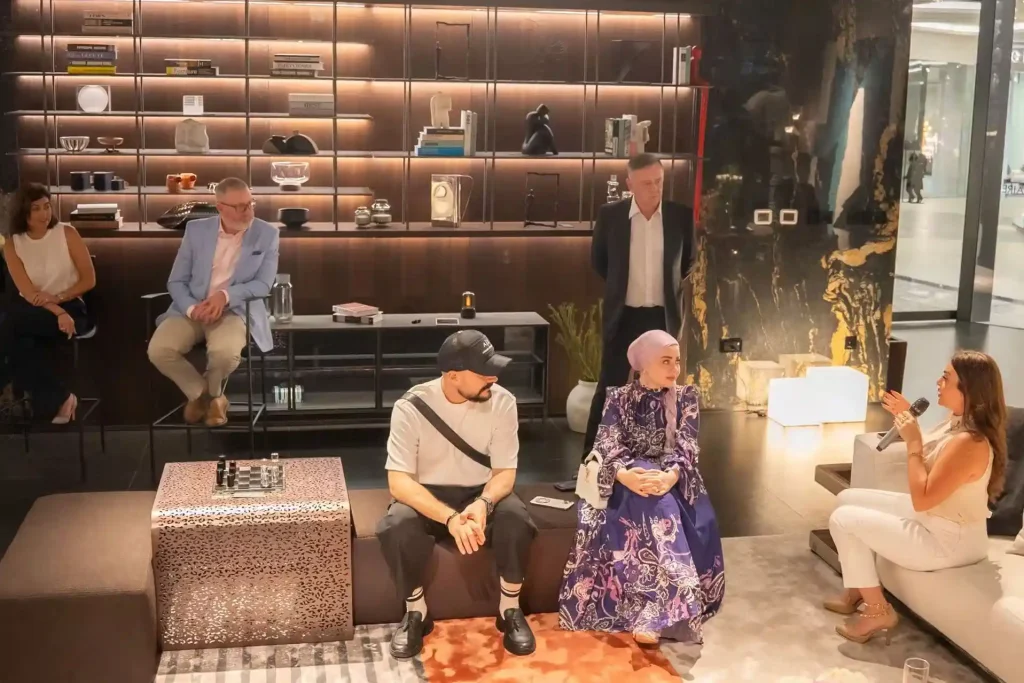Introduction
In today’s hyperconnected world, interior design is no longer confined to physical spaces — it extends into digital ecosystems where stories, visuals, and community engagement define success, shaping both the present and laying the foundation for future possibilities.
This was the central theme of Designed to Hook, the exclusive event hosted on April 24, 2025, at La Maisonaire showroom.
Featuring industry leaders such as Dustin Bradnick (Say Studio), Kevin Mashford (Spencer Interiors), Nada Abdel Khalek (ISG Middle East), and a live styling session with design influencer Nour Aljabri, the event examined how media, marketing, and evolving lifestyle needs are rewriting the rules of creative spaces, opening new doors for innovation and potential.
Nour Aljabri: Styling with Narrative Power
Before the panel discussion, Nour Aljabri — interior designer, content creator, and a trusted name among Middle Eastern celebrities — led an immersive session on “shelf storytelling,” giving attendees a deep dive into her creative process.
Educated between Italy and the Middle East, Nour blends timeless elegance with current digital trends.
Her projects for Joelle Mardinian, Noor Stars, Shaza Hassoun, and Saif Nabeel are a masterclass in design as a tool for communication, not merely decoration.
Nour’s work demonstrates that successful interiors today are designed as living content, both for personal brands and for businesses looking to elevate their image.
Designing the New Office: Comfort, Identity, Flexibility
The panel discussion featuring Dustin Bradnick, Kevin Mashford, and Nada Abdel Khalek focused on the challenges and opportunities emerging from a design world increasingly shaped by social media.
Responding to the question “How are you adapting to the changing design/furniture landscape?”, the speakers reflected on how the post-pandemic world has accelerated major transformations in workplace design — changes that are actively shaping the future of our industry.
Today’s trends show that workspaces must:
- Feel like home: Comfort-centered environments are essential to support employee well-being and to foster hybrid work models.
- Be flexible: Modular furniture, transformable spaces, and hot-desking solutions are no longer optional — they represent the new standard of comfort and adaptability.
- Foster belonging: Offices must now reflect corporate identity and culture, playing a crucial role in attracting and retaining talent.
The shift is clear: contemporary design aims to create experiential spaces that are not only functional but also emotional and deeply representative of a brand’s identity — both physically and digitally.
Social Media: The New Business Backbone for Designers
Social media has become the backbone of visibility, positioning, and client acquisition for interior designers. It’s no longer optional — it’s fundamental.
Yet, success is no longer tied to simply posting beautiful images, as it might have been a few years ago.
Today’s designers are prioritizing thought leadership, process transparency, emotional storytelling, and most importantly — transforming attention into trust, and trust into business.
At the heart of this transformation is LinkedIn, which has evolved from a digital resume platform into a powerful space for B2B authority and industry dialogue. Designers now use it to spark conversations about innovation, workplace evolution, and creative trends, while also sharing case studies and impactful reports. This builds trust with peers and potential clients, while positioning them as thought leaders in the broader design community.
Meanwhile, Instagram remains the go-to for visual storytelling. It’s the ideal platform for before-and-after showcases, mood boards, and behind-the-scenes content that humanizes a brand. Instagram creates connections, opens opportunities to attract new clients, and invites the audience into the designer’s creative world through its primarily visual communication style.
Pinterest, on the other hand, has solidified itself as a high-intent discovery platform. Its users are actively planning and searching for inspiration. Designers can harness this intent by creating SEO-optimized boards, trend collections, and service-based visual catalogues.
Then there’s TikTok, where authenticity trumps perfection. It’s all about the process, not the polish. Designers use TikTok to share “day in the life” content, design tips, and transformation videos. TikTok is ideal for reaching wider audiences through unfiltered, engaging, and relatable content.
And when it comes to professional credibility, Behance remains the benchmark for showcasing creative portfolios. With detailed case studies, 3D renderings, and commercial projects, it allows designers to present their full creative potential and attract agencies and collaborators in the industry.
Key Takeaways:
- LinkedIn: Use to establish thought leadership and engage in B2B networking.
- Instagram: Focus on emotional branding, storytelling, and behind-the-scenes insights.
- Pinterest: Leverage for discovery and SEO-optimized inspiration boards.
- TikTok: Embrace authenticity and share real, process-driven content.
- Behance: Curate a professional portfolio to demonstrate expertise and attract creative opportunities.
Looking ahead, new trends are reshaping how designers approach these platforms.
First, there’s an increasing appetite for behind-the-scenes and process-driven content. Audiences are no longer satisfied with just the finished space — they want to understand the ideas, decisions, and challenges behind the design. By sharing the step-by-step process — from ideation to execution — designers can foster deeper engagement and credibility.
Another rising trend is the power of micro-influencers and niche authority. Rather than chasing mass exposure, many designers are seeing stronger results through smaller, targeted collaborations with lifestyle or design-focused micro-creators. The value lies in their authenticity, spontaneity, and the strong communities that support them.
Lastly, there’s a major shift toward community building. Designers are no longer just aiming to grow audiences — they’re nurturing ecosystems. This involves active engagement on Instagram Stories, curated Pinterest boards, and even LinkedIn groups that facilitate industry dialogue. Building these communities results in stronger relationships and a more loyal, interactive following.
Conclusion
The role of social media in design is evolving. It’s no longer about simply sharing pretty spaces — it’s about creating meaningful, authentic content that builds trust, deepens relationships, and drives real business growth.
By understanding the unique strengths of each platform, designers can elevate their visibility, communicate their value, and connect with clients in more powerful, lasting ways.




